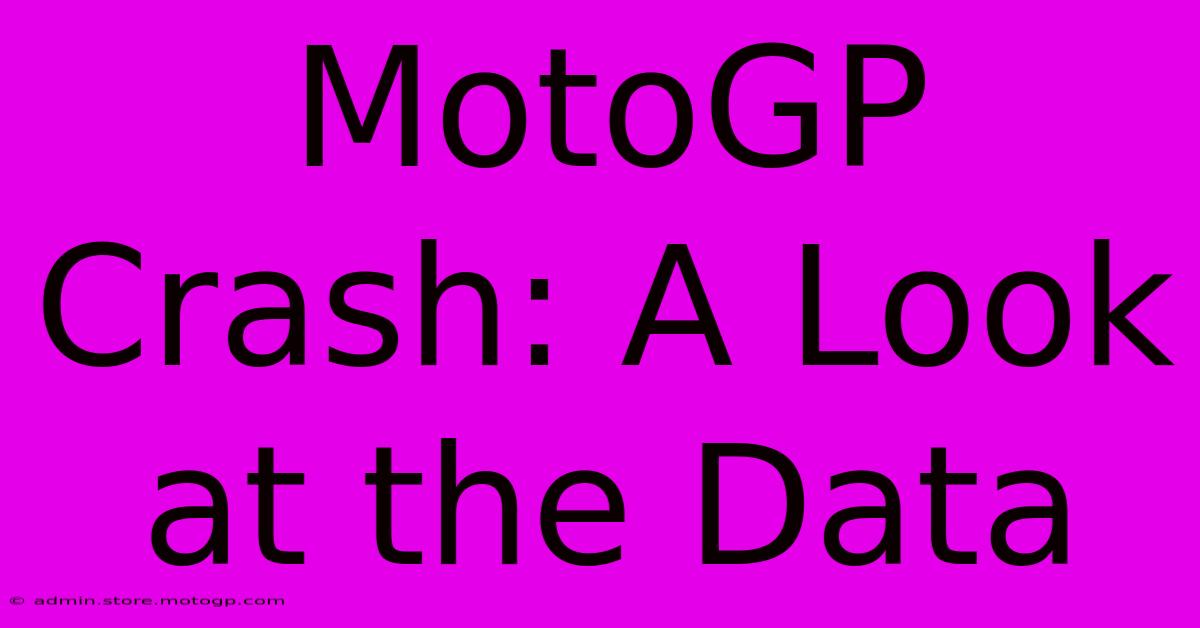MotoGP Crash: A Look At The Data

Table of Contents
MotoGP Crash: A Look at the Data
Motorcycle racing, particularly at the MotoGP level, is a breathtaking spectacle of speed, skill, and precision. However, the inherent risks are undeniable. High speeds, aggressive overtaking maneuvers, and unforgiving tracks all contribute to the possibility of crashes. Understanding these crashes, analyzing the data behind them, and learning from them is crucial for improving rider safety and enhancing the sport itself. This article delves into the data surrounding MotoGP crashes, exploring the contributing factors and potential solutions.
Understanding the Data Sources
Analyzing MotoGP crashes requires access to various data sources. These include:
- Telemetry data: This provides crucial information on bike speed, lean angle, throttle position, braking force, and other parameters immediately before, during, and after a crash. This data is usually proprietary to the teams and manufacturers but can offer incredibly valuable insights.
- Onboard camera footage: While not quantifiable data, video footage is essential for qualitative analysis. It allows experts to visually reconstruct the events leading to a crash, identifying potential contributing factors that telemetry might miss.
- Trackside camera footage: Similar to onboard footage, multiple trackside camera angles provide a comprehensive view of the incident, assisting in understanding the overall dynamics of the crash.
- Rider interviews and reports: Post-crash interviews with riders can provide valuable subjective insights into their perception of the events, helping to understand the human factor in crashes.
- Accident reports from the FIM (Fédération Internationale de Motocyclisme): These official reports often contain detailed analyses of incidents, outlining contributing factors and potential safety improvements.
Common Causes of MotoGP Crashes
Analyzing the available data reveals several recurring causes of MotoGP crashes:
1. Loss of Traction:
This is perhaps the most frequent cause. High speeds, combined with aggressive braking or cornering, can lead to a loss of traction, resulting in a high-side (rear wheel slides out) or low-side (front wheel slides out) crash. Wet track conditions significantly exacerbate this risk. Telemetry data can pinpoint the exact moment of traction loss, allowing for analysis of rider technique and bike setup.
2. Contact with Other Riders:
Overtaking maneuvers, especially at high speed, carry significant risks. Collisions are a common cause of crashes, often resulting in multiple riders being involved. Analysis of this type of crash involves examining racing lines, braking points, and the relative speeds of the involved bikes.
3. Mechanical Failures:
While less frequent, mechanical failures can lead to devastating crashes. Tire punctures, brake failures, or engine problems can suddenly leave a rider with little or no control. This highlights the importance of meticulous bike maintenance and regular inspections.
4. Track Conditions:
The condition of the track itself is a critical factor. Oil spills, debris on the track, or uneven surfaces can catch riders off guard, causing unexpected loss of traction. This emphasizes the need for rigorous track maintenance and effective track marshaling.
Improving Safety in MotoGP
The data gathered from crashes is invaluable in improving rider safety:
- Track modifications: Analyzing crash data can reveal dangerous sections of the track, leading to design improvements and safety enhancements.
- Rider training: Identifying common causes of crashes allows for tailored training programs focusing on specific techniques like braking and cornering.
- Technological advancements: Data analysis can inform the development of improved safety technologies, such as advanced traction control systems and enhanced safety gear.
Conclusion:
The seemingly chaotic nature of MotoGP crashes hides a wealth of data that can be analyzed to improve safety and enhance the sport. By combining quantitative data from telemetry and qualitative data from video footage and rider reports, we can gain a deeper understanding of the causes of crashes and implement effective solutions to mitigate future risks. The continuous effort to analyze this data is crucial for ensuring the future of MotoGP remains a thrilling spectacle while prioritizing the safety of its riders.

Thank you for visiting our website wich cover about MotoGP Crash: A Look At The Data. We hope the information provided has been useful to you. Feel free to contact us if you have any questions or need further assistance. See you next time and dont miss to bookmark.
Featured Posts
-
Cota Parking Pre Race Parking Strategies
Feb 18, 2025
-
Moto 3 Bikes The Science Behind Moto 3 Performance
Feb 18, 2025
-
Show Your Cota Pride Gift Shop Exclusives
Feb 18, 2025
-
Moto2 Specs The Ultimate Guide To Performance
Feb 18, 2025
-
The Greatest Moto Gp Rider A Statistical Analysis
Feb 18, 2025
